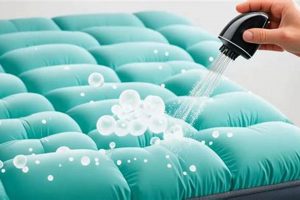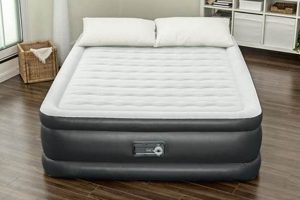These specialized support surfaces are designed to alleviate pressure on the body by cyclically inflating and deflating air cells. This dynamic redistribution of pressure helps to prevent prolonged compression of tissues, especially over bony prominences. As an example, a patient confined to bed for extended periods may use one to reduce the risk of pressure ulcer development.
The significance of such systems lies in their ability to promote circulation and minimize the potential for tissue damage caused by immobility. Historically, these systems represent a significant advancement in patient care, moving beyond static surfaces to offer proactive pressure management. Their benefits include enhanced patient comfort, reduced nursing workload, and a decrease in the incidence of pressure injuries, leading to improved patient outcomes and reduced healthcare costs.
The subsequent sections will delve into the specific types available, the operational mechanisms involved, the clinical applications, proper usage guidelines, and the crucial factors to consider when selecting an appropriate model for a given individual or situation.
Optimizing Use
The following recommendations aim to maximize the effectiveness and longevity of pressure redistribution systems. Adhering to these guidelines ensures optimal patient comfort and therapeutic benefit.
Tip 1: Confirm Correct Inflation: Prior to patient placement, verify that the system is fully inflated according to the manufacturer’s instructions. Insufficient inflation reduces pressure relief capabilities.
Tip 2: Select Appropriate Cycle Time: Adjust the cycle time to suit the individual’s needs and risk factors. Shorter cycles provide more frequent pressure changes, while longer cycles may be suitable for less vulnerable individuals. Consult with a healthcare professional to determine the optimal setting.
Tip 3: Regularly Inspect the Surface: Conduct routine inspections to identify and address any potential damage, leaks, or malfunctions. Promptly repair or replace any compromised components to maintain efficacy.
Tip 4: Ensure Proper Weight Distribution: Distribute the patient’s weight evenly across the surface to prevent localized pressure concentrations. Utilize positioning devices as necessary to maintain optimal alignment.
Tip 5: Maintain Hygiene Protocols: Implement strict hygiene practices to prevent contamination and infection. Regularly clean the surface with appropriate disinfectant solutions, following the manufacturer’s recommendations.
Tip 6: Observe Skin Condition: Routinely assess the patient’s skin for any signs of irritation or breakdown. Implement preventative measures, such as barrier creams or moisture-wicking dressings, as needed.
Tip 7: Monitor Pressure Settings: Periodically review and adjust the pressure settings based on the patient’s weight and clinical condition. Significant weight changes or altered health status may necessitate recalibration.
Adherence to these guidelines contributes to enhanced patient well-being and the prevention of pressure-related complications. Consistent implementation promotes therapeutic effectiveness and extends the lifespan of the equipment.
The subsequent section will address specific clinical applications and considerations for diverse patient populations.
1. Pressure Redistribution
The central function of an alternating pressure air mattress is pressure redistribution. Prolonged, concentrated pressure on specific areas of the body, especially over bony prominences, impedes blood flow and leads to tissue ischemia, potentially resulting in pressure injuries. An alternating pressure air mattress mitigates this risk by systematically inflating and deflating internal air cells. This cyclical alteration of pressure points prevents any single area from bearing sustained weight, thereby promoting consistent blood circulation and oxygen delivery to vulnerable tissues. A patient confined to a bed for an extended recovery period, for example, benefits directly from this dynamic pressure management. The constant shifting of support minimizes the risk of ulcer formation, a common complication in immobile patients.
The effectiveness of pressure redistribution hinges on several factors integral to the design and operation of the support surface. The cycle time, or the duration of inflation and deflation, must be appropriately calibrated to the individual’s needs and risk profile. Shorter cycles provide more frequent pressure changes, offering heightened protection for high-risk individuals. Similarly, the pressure settings must be adjusted to the patient’s weight to ensure adequate offloading without compromising comfort or stability. The choice of material also plays a role; durable, low-friction surfaces minimize shear forces that can contribute to skin breakdown. A properly functioning pump and an intact air cell network are essential for maintaining the integrity of the pressure redistribution system. Failure of any of these components can compromise the system’s efficacy and increase the risk of pressure injuries.
In summary, pressure redistribution is not merely a feature of an alternating pressure air mattress; it is its defining characteristic and primary therapeutic mechanism. Understanding the underlying principles of this process, coupled with careful selection, proper usage, and diligent maintenance of the support surface, is paramount in preventing pressure injuries and promoting positive patient outcomes. The challenge lies in tailoring the system to the specific needs of each individual and ensuring consistent adherence to established protocols.
2. Cycle Duration
Cycle duration, in the context of an alternating pressure air mattress, refers to the time interval over which the inflation and deflation of individual air cells occurs. This parameter dictates the frequency at which pressure is redistributed across the patient’s body. A shorter cycle duration results in more frequent pressure changes, whereas a longer duration provides less frequent alteration of weight-bearing surfaces. The selection of an appropriate cycle duration is not arbitrary; it is a critical determinant of the system’s effectiveness in preventing pressure injuries. Insufficient frequency may fail to adequately relieve pressure, particularly in vulnerable individuals, while excessive frequency might compromise patient comfort or disrupt sleep patterns.
The practical significance of understanding cycle duration becomes evident in clinical settings. For instance, a frail, elderly patient with compromised skin integrity might require a shorter cycle duration to maximize pressure relief and minimize the risk of tissue breakdown. Conversely, a younger, more robust individual might tolerate a longer cycle duration without adverse effects. Furthermore, the optimal
cycle duration may vary depending on the specific model of the air mattress and the patient’s position. Some systems offer adjustable cycle durations, allowing healthcare providers to tailor the pressure redistribution to individual needs. Regular monitoring of the patient’s skin condition and assessment of their comfort level are essential to determine the most appropriate setting. In cases where redness or other signs of pressure injury development are observed, the cycle duration should be re-evaluated and adjusted accordingly.
In conclusion, cycle duration is an indispensable component of an alternating pressure air mattress, profoundly impacting its ability to prevent pressure injuries. Its careful selection and adjustment, guided by clinical assessment and patient feedback, are paramount for optimizing therapeutic outcomes. However, challenges remain in determining universally applicable guidelines for cycle duration, as individual needs vary considerably. Therefore, a personalized approach, coupled with ongoing monitoring and adaptation, is crucial for maximizing the benefits of alternating pressure air mattresses in diverse patient populations.
3. Weight Capacity
Weight capacity is a critical specification of any alternating pressure air mattress, directly influencing its performance, safety, and therapeutic efficacy. It represents the maximum weight the mattress can support while maintaining optimal pressure redistribution and structural integrity. Exceeding this limit can compromise the mattress’s ability to effectively alleviate pressure, potentially leading to increased risk of pressure injuries, equipment failure, and patient discomfort.
- Structural Integrity
Weight capacity is directly related to the mattress’s structural integrity. The internal air cells, supporting framework, and outer materials are engineered to withstand specific weight limits. Exceeding these limits can cause cell rupture, deformation, or overall structural failure, rendering the mattress ineffective and potentially unsafe for the patient. Such failures can lead to uneven pressure distribution, localized pressure points, and an increased risk of skin breakdown.
- Pressure Redistribution Effectiveness
The ability of an alternating pressure air mattress to effectively redistribute pressure is contingent upon adhering to its weight capacity. When the mattress is overloaded, the air cells may not inflate or deflate properly, leading to static pressure in certain areas. This defeats the purpose of the alternating pressure mechanism, negating its pressure-relieving benefits. For instance, if a patient significantly exceeds the recommended weight limit, bony prominences such as the sacrum or heels may experience constant pressure, increasing the likelihood of pressure ulcer development.
- Pump Performance
The pump unit responsible for inflating and deflating the air cells is designed to operate within a specific range of weight and pressure. Exceeding the weight capacity forces the pump to work harder, potentially leading to premature wear and tear, reduced efficiency, or complete pump failure. This can result in inadequate air circulation and diminished pressure redistribution, compromising the mattress’s therapeutic function. A failing pump may also exhibit increased noise levels, further impacting patient comfort.
- Patient Safety and Comfort
Adhering to the specified weight capacity ensures patient safety and comfort. An overloaded mattress may become unstable or sag, increasing the risk of falls or positional discomfort. Moreover, inadequate pressure redistribution can lead to pain, discomfort, and agitation, negatively impacting the patient’s overall well-being. Choosing a mattress with an appropriate weight capacity that accommodates the patient’s weight is thus crucial for preventing complications and promoting a comfortable and therapeutic environment.
The weight capacity of an alternating pressure air mattress is not merely a technical specification; it is a fundamental parameter that dictates its effectiveness and safety. Healthcare providers must carefully consider the patient’s weight when selecting a mattress, ensuring that it falls within the recommended weight range. Regular monitoring of the mattress’s performance and adherence to manufacturer guidelines are essential for maintaining its integrity and optimizing patient outcomes. Disregarding weight capacity can have serious consequences, underscoring the importance of selecting an appropriate mattress for each individual.
4. Material Composition
The materials used in the construction of an alternating pressure air mattress significantly influence its performance, durability, hygiene, and patient comfort. Material selection is a critical aspect of the design process, impacting the mattress’s ability to effectively redistribute pressure and withstand the rigors of prolonged use.
- Outer Cover Materials
The outer cover materials commonly include coated nylon, polyurethane, or specialized fabrics. These materials provide a protective barrier, resist fluid penetration, and facilitate cleaning and disinfection. For instance, a waterproof polyurethane coating prevents bodily fluids from seeping into the mattress’s internal components, reducing the risk of bacterial growth and cross-contamination. The choice of material also impacts the mattress’s breathability and friction coefficient, affecting patient comfort and shear force reduction.
- Air Cell Materials
Air cells, the core components responsible for pressure redistribution, are typically constructed from polyvinyl chloride (PVC) or thermoplastic polyurethane (TPU). These materials offer flexibility, durability, and air impermeability. PVC is a cost-effective option, while TPU provides enhanced tear resistance and flexibility, especially in cold environments. The thickness and quality of the air cell material directly affect its ability to maintain consistent pressure and withstand repeated inflation and deflation cycles.
- Internal Support Structures
Some alternating pressure air mattresses incorporate internal support structures, such as foam layers or baffles, to enhance stability and prevent bottoming out. These structures are often made from polyurethane foam or polyethylene materials. The density and configuration of the internal supports influence the mattress’s overall support characteristics and weight distribution capabilities. Properly designed internal structures can improve patient comfort and prevent excessive pressure on bony prominences.
- Pump Components
The materials used in the pump unit, including plastics, metals, and rubber components, contribute to its reliability and lifespan. Durable plastics and corrosion-resistant metals are essential for withstanding continuous operation and environmental factors. The diaphragms and valves within the pump must be made from flexible, resilient materials that can withstand repeated cycles of pressure and vacuum. The quality of the pump components directly impacts the mattress’s ability to maintain consistent and effective pressure redistribution.
The selection of appropriate materials for an alternating pressure air mattress involves a careful balance of performance, cost, and regulatory considerations. The materials mus
t meet specific requirements for biocompatibility, flammability resistance, and ease of cleaning. Ongoing research and development efforts focus on incorporating advanced materials that offer enhanced durability, improved pressure redistribution capabilities, and increased patient comfort. The longevity and effectiveness of the alternating pressure air mattress are intrinsically linked to the properties and quality of its constituent materials.
5. Pump Mechanism
The pump mechanism is the driving force behind the cyclical pressure changes that define an alternating pressure air mattress. Its functionality is paramount to the mattress’s therapeutic effectiveness and proper operation. A malfunctioning or inefficient pump compromises the entire system’s ability to redistribute pressure, potentially increasing the risk of pressure injuries.
- Air Delivery System
The pump’s air delivery system comprises components responsible for drawing in, compressing, and distributing air to the mattress’s air cells. This includes the intake filter, compressor, valves, and connecting tubing. The compressor generates the necessary pressure to inflate the cells, while the valves regulate airflow to specific zones. A robust delivery system ensures consistent and reliable pressure changes. Malfunctions, such as leaks in the tubing or a failing compressor, can result in inadequate pressure redistribution and reduced therapeutic benefit.
- Cycle Control System
The cycle control system governs the timing and duration of inflation and deflation cycles. This is typically achieved through electronic timers or microcontrollers that regulate the opening and closing of valves. Accurate cycle control is essential for maintaining the desired pressure redistribution pattern. Inaccurate timing can lead to uneven pressure distribution, compromising the mattress’s effectiveness. Some advanced systems offer adjustable cycle durations, allowing clinicians to tailor the pressure redistribution to individual patient needs.
- Pressure Regulation
The pump mechanism incorporates pressure sensors and regulators to maintain consistent air pressure within the mattress’s air cells. These components monitor the pressure levels and adjust the compressor output to compensate for leaks or changes in patient weight. Effective pressure regulation ensures that the mattress provides optimal support and pressure relief, regardless of variations in external factors. Failure of the pressure regulation system can result in either over-inflation, leading to excessive pressure, or under-inflation, compromising pressure redistribution.
- Noise and Vibration Dampening
The operation of the pump mechanism inevitably generates noise and vibration. Noise and vibration dampening features, such as insulated housings and vibration-absorbing mounts, minimize these disturbances to promote patient comfort and a restful sleep environment. Excessive noise can be disruptive, particularly for patients in sensitive care settings. Effective dampening mechanisms contribute to a more conducive healing environment. The noise level of the pump is often a significant consideration when selecting an alternating pressure air mattress for home or clinical use.
These elements of the pump mechanism are not isolated; they are interconnected and interdependent. A deficiency in one area can cascade and affect the performance of the entire system. Therefore, a comprehensive understanding of the pump mechanism and its various components is crucial for selecting, maintaining, and troubleshooting alternating pressure air mattresses to ensure optimal patient outcomes and prevent pressure-related complications.
6. Support Surface
A “support surface” is the foundational element of any “alternating pressure air mattress.” It is the direct interface between the patient and the pressure redistribution system. Without a properly functioning and appropriately selected support surface, the benefits of alternating pressure technology are significantly diminished. The effectiveness of an “alternating pressure air mattress” in preventing pressure injuries is directly contingent upon the design and capabilities of its support surface. For example, a support surface constructed from materials with poor moisture-wicking properties can trap perspiration, increasing the risk of skin maceration and subsequent breakdown, despite the alternating pressure functionality.
Further, the type of material used in the support surface significantly influences the reduction of shear forces. Shear forces, arising from friction between the patient’s skin and the mattress, contribute to pressure injury development. A low-friction support surface, in conjunction with the alternating pressure mechanism, minimizes these damaging forces. Consider a scenario where a patient slides down an inclined bed; a support surface with a high coefficient of friction will exacerbate shear stress on the sacrum, negating some of the benefits provided by the alternating inflation and deflation cycles. Clinical protocols should emphasize the importance of selecting appropriate support surfaces in conjunction with alternating pressure systems.
In summary, the “support surface” is not merely an accessory to an “alternating pressure air mattress”; it is an integral component that directly impacts its efficacy. Understanding the relationship between support surface characteristics such as material composition, moisture permeability, and friction coefficient and the alternating pressure mechanism is crucial for effective pressure injury prevention. The challenge lies in tailoring the support surface selection to individual patient needs and risk factors, alongside consistent implementation of established care protocols to maximize therapeutic outcomes.
Frequently Asked Questions Regarding Alternating Pressure Air Mattresses
The following questions and answers address common concerns and misconceptions regarding alternating pressure air mattresses. This information is intended to provide a clear understanding of their functionality, application, and limitations.
Question 1: What is the primary purpose of an alternating pressure air mattress?
The primary purpose is to redistribute pressure, reducing the risk of pressure injuries in individuals with limited mobility. The cyclical inflation and deflation of air cells prevent prolonged pressure on specific areas of the body, promoting blood circulation and preventing tissue damage.
Question 2: How does an alternating pressure air mattress differ from a standard air mattress?
An alternating pressure air mattress features dynamic pressure redistribution, whereas a standard air mattress provides static support. Standard air mattresses offer cushioning but do not actively change pressure points, making them unsuitable for pressure injury prevention.
Question 3: What factors should be considered when selecting an alternating pressure air mattress?
Key factors include the patient’s weight, risk level for pressure injuries, mattress weight capacity, cycle duration options, material composition, and pump noise level. Clinical evaluation and consultation with healthcare professionals are recommended.
Question 4: How often should an alternating pressure air mattress be cleaned and disi
nfected?
Cleaning and disinfection protocols should adhere to manufacturer’s guidelines and institutional policies. Typically, the mattress should be cleaned and disinfected between patients and regularly inspected for damage or contamination. Using appropriate cleaning agents is essential to prevent material degradation.
Question 5: Are alternating pressure air mattresses suitable for all patients?
While beneficial for many, these mattresses are not universally suitable. Contraindications may exist for patients with unstable spinal injuries, certain types of fractures, or conditions requiring a firm, stable support surface. Medical evaluation is necessary to determine appropriateness.
Question 6: What are the potential drawbacks of using an alternating pressure air mattress?
Potential drawbacks include pump noise, which may disrupt sleep; the risk of air cell leaks or pump malfunction, requiring regular maintenance; and the need for proper training of caregivers to ensure correct usage and monitoring.
In summary, alternating pressure air mattresses are valuable tools for pressure injury prevention, but their effectiveness depends on proper selection, use, and maintenance. A thorough understanding of their capabilities and limitations is crucial for optimizing patient outcomes.
The subsequent section will address emerging trends and future directions in alternating pressure support surface technology.
Conclusion
The preceding discussion has explored the multifaceted nature of the alternating pressure air mattress, outlining its functionality, benefits, and critical considerations for effective implementation. Key points include the importance of pressure redistribution, appropriate cycle duration, adherence to weight capacity guidelines, material composition factors, the role of the pump mechanism, and the significance of the support surface. Proper selection, utilization, and maintenance are paramount for maximizing patient outcomes and mitigating the risk of pressure-related complications.
The alternating pressure air mattress represents a significant advancement in preventative healthcare, yet its full potential can only be realized through diligent application of evidence-based practices and ongoing refinement of technology. Continued research, coupled with rigorous clinical evaluation, is essential to optimize pressure redistribution strategies and improve the overall efficacy of these systems. The proactive integration of this technology remains a crucial component of comprehensive patient care, underscoring its continued relevance in the pursuit of enhanced patient well-being and reduced healthcare burden.







